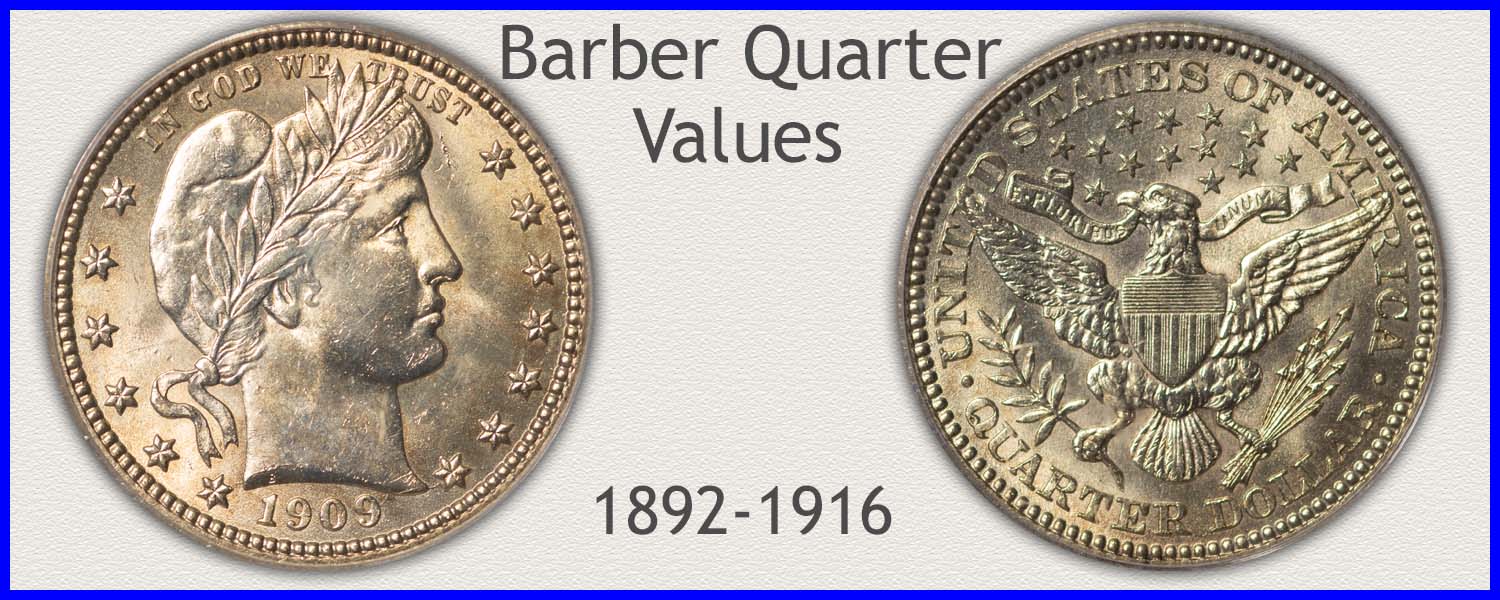Coin Values Moving with Precious Metals: Up-Dated 12/29/2025: Gold $4449 | Silver $75.46
1902 Quarter Value
Potential premium 1902 quarter value is discovered by following a few steps and using a series of images.
Accurate date and mint identity are important parts of a coin's value, followed by a judgment of its condition. When used together, this narrows down the worth of a Barber quarter.
Each Barber quarter contains 90% silver, and is a popular collectible today. Collecting this vintage series is of interest to collectors at all levels, from beginners to experts. A quarter's range on the chart is narrowed when base silver quality examples are separated from higher-end coins.
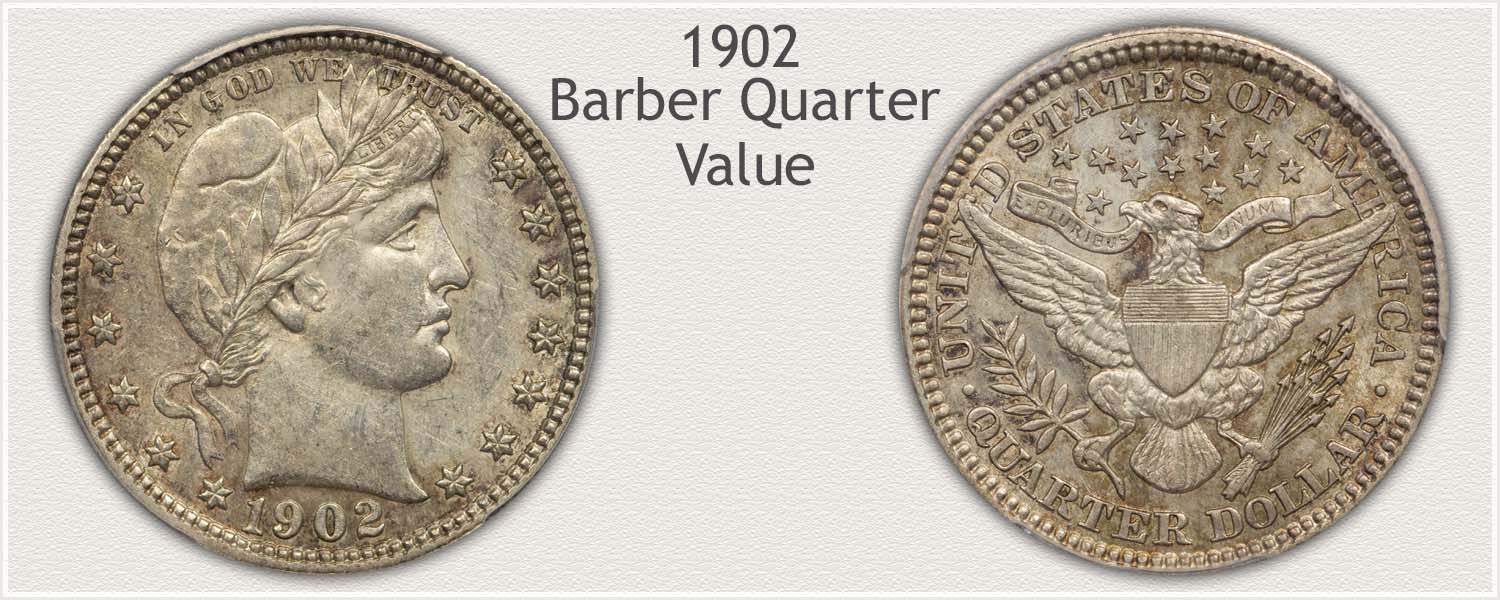
Steps Leading to Value:
- Step 1: Date and Mintmark Variety - Finding and noting the mintmarks on these old quarters is a key first step to an accurate description and full evaluation.
- Step 2: Grading Condition - When your coin is closely matched to the grading images, the range of values on the chart is narrowed.
- Step 3: Special Qualities - It is not uncommon for values to rise because of subtle factors. When determining value, originality factors are considered.
| 1902 Quarter Value | ||||
|---|---|---|---|---|
| Condition of Coin | ||||
| Date | Good | Fine | Extremely Fine | Mint State |
| Barber Quarter Values Updated | 12/29/2025 | |||
| 1902 | $18.21 | $24 | $68 | $238 |
| 1902 O | $20.97 | $47 | $135 | $525 |
| 1902 S | $29.80 | $55 | $135 | Rare |
Use the chart to determine a range of wholesale values, what a dealer pays for these old Barber quarters.
Step 1: | Date and Mint Varieties to Recognize
Mint Varieties of the Barber Quarter Series
The Philadelphia variety quarter is considered abundant today due to high numbers struck in 1902. Branch mint varieties of New Orleans and San Francisco quarters are far more difficult to find.
Each of the branch mints striking quarters is identified by its mintmark. Using the images below, these mintmarks are found and verified.
1902-S Barber Quarter
"S" Mintmark on Reverse: San Francisco Mint Struck the Coin
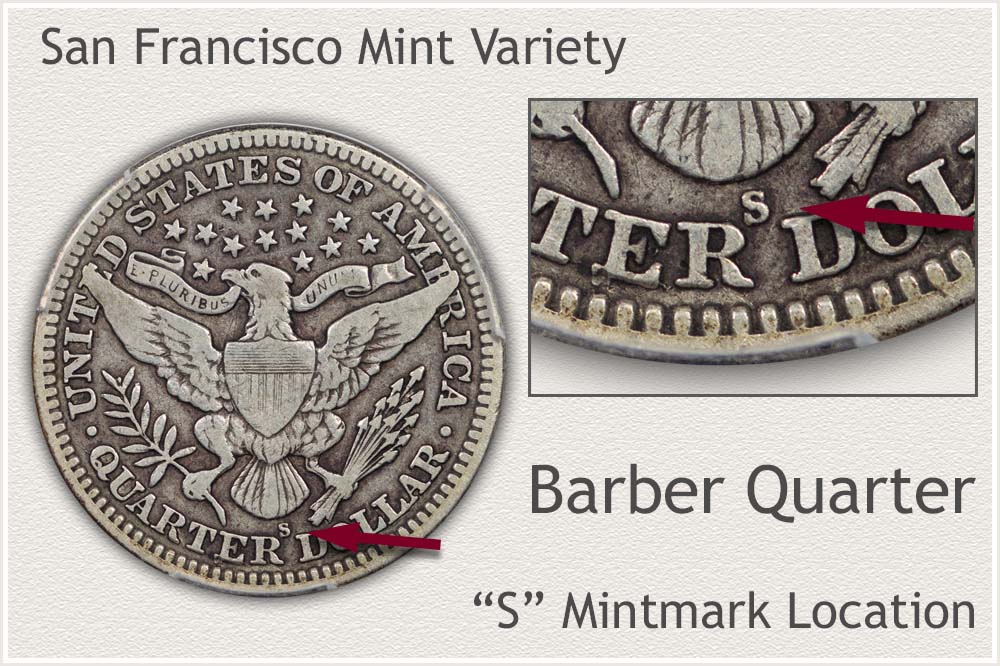
A 1902 San Francisco quarter is a popular mint variety of the Barber series. Listed on the chart with a premium value, new and beginning collectors appreciate the overall scarcity of the mint issue. Struck in low numbers in comparison with other mint's production, just 1,524,612 were released into circulation. Any U.S. coin minted in the early twentieth century is now a very old coin.
All Barber quarters are a 90% silver alloy, worth well above face value, and have not circulated since the early 1960's. A vintage series, and a premium mint variety.
A U.S. Branch Mint is located in San Francisco. In order to identify its coins during the Barber series, the mint used an "S" mintmark. The letter "S" mark is seen on the reverse of the coin, just below the eagle's tail feathers.
1902-O Barber Quarter
"O" Mintmark on Reverse: New Orleans Mint Struck the Coin
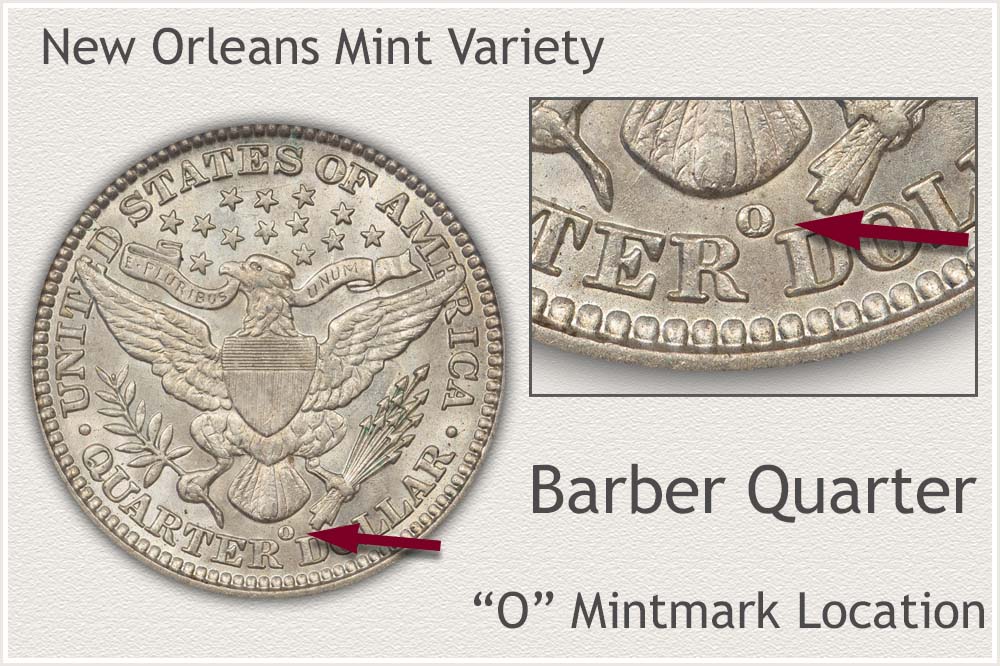
The majority of 1902 New Orleans quarters that entered circulation saw extended use resulting in today's remaining examples now heavily worn. There are ample amounts trading in an active market, their worth rises and falls with silver value. The mint recorded over 4.7 million Barber quarters were struck in New Orleans in the year, with most of them serving in commerce for many years. Coins of low to average quality are abundant.
Recognizing the "O" mintmark of the New Orleans mint and evaluating condition are key to determining premium value. Above average grade Barber quarters are hard to find for collectors and specialists of the New Orleans mint's issues. This higher quality collector coin carries a premium value and demand.
Examine the coin's reverse, particularly the area directly below the eagle's tail feathers. All New Orleans' coinage bears an "O" mintmark. The "O" mintmark on the example coin confirms its New Orleans mint production.
1902 Barber Quarter
No Mintmark on Reverse: Philadelphia Mint Struck the Coin
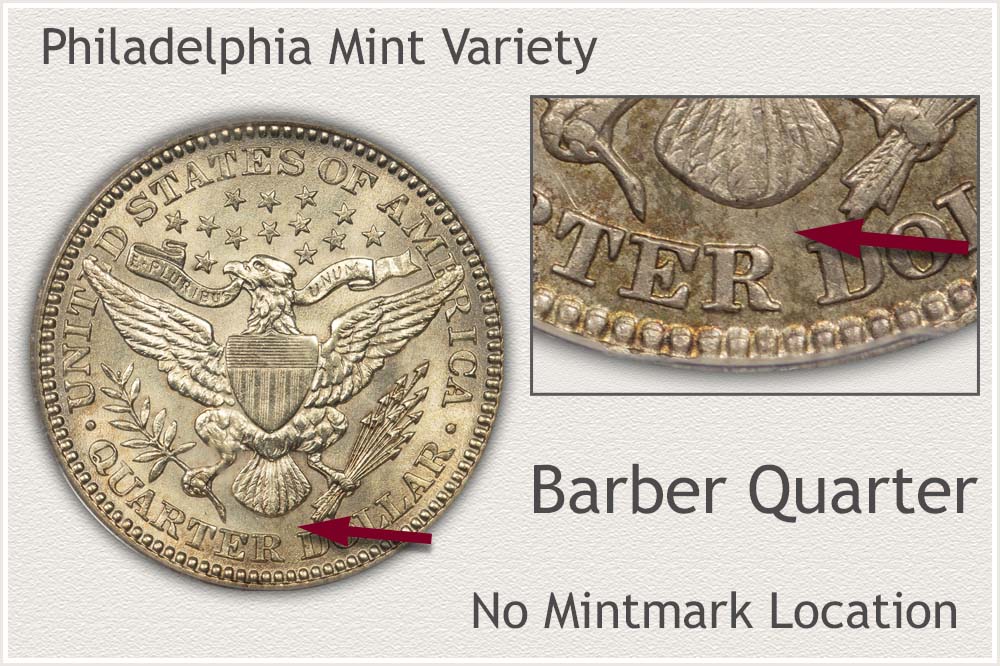
During the years of the Barber series, the Philadelphia mint became the output leader, far exceeding the other mints in production. The total number of quarters that were struck in 1902 was 12.1 million pieces. A coin in highly worn condition is still readily available today.
Examples at the lower end of the condition scale are valued based on the current silver price. Part of an obsolete series and from the early twentieth century, the date is popular with collectors. These coins are now very old.
Absence of a mintmark on the reverse identifies the mint variety. In this era, a mintmark was not present on Philadelphia quarters. If the area is empty near the bottom reverse of the coin, above "Quarter Dollar," it identifies Philadelphia as the mint that struck the coin.
Step 2: | A Process to Grading Condition
Judge and Recognize 1902 Quarter Value by its Condition
The state of preservation determines the value of these Barber quarters as collectibles. A higher grade and condition are determined by recognizing more detail remaining in the design. Grades are used to define the condition of coins, place a narrow and certain value range on them.
To see the finer features described, a magnifying glass is often used. Highlighting the coin's surface with a single light source creates contrast to bring out small details. To see the complete details that existed when these quarters were first minted, examine a Mint State coin first. Wear, as it lowers condition, starts to show with flattening of the highest relief areas. These key spots are illustrated in the different grades.
Mint State Grade
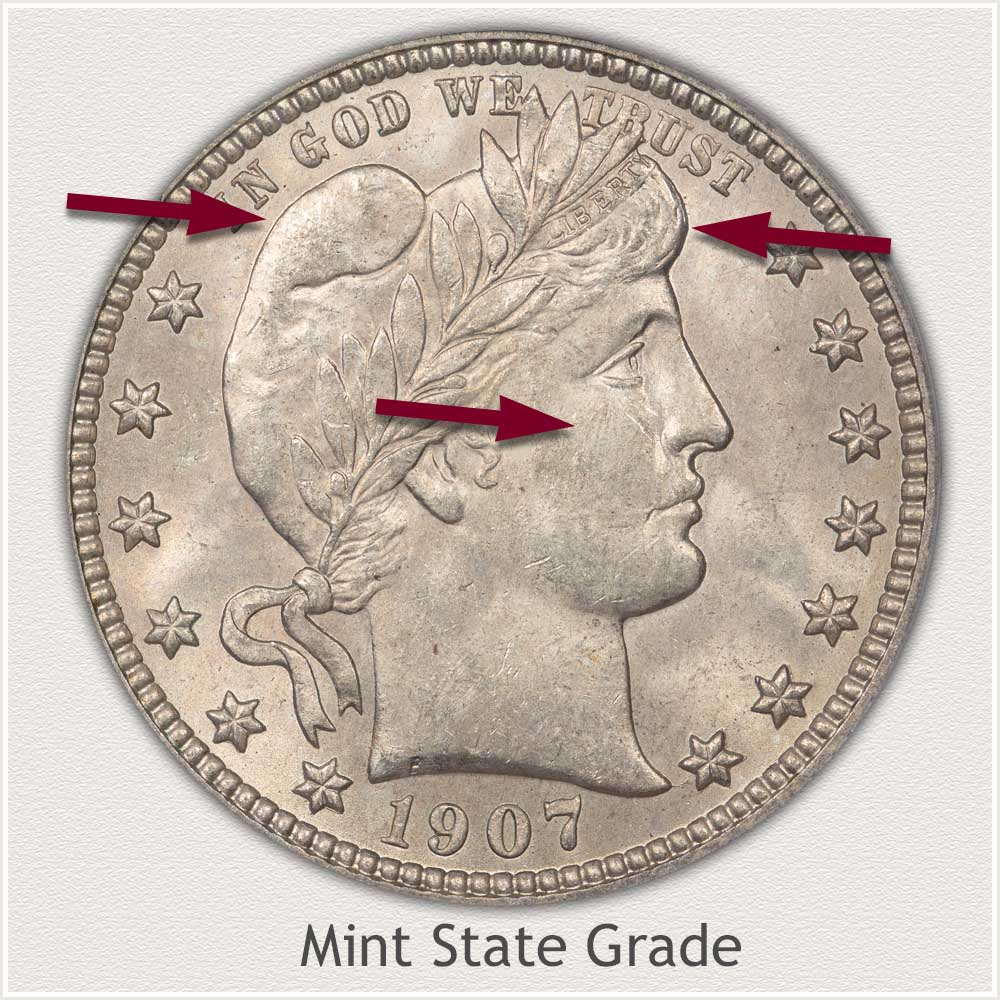
Mint State: A collector values a coin's Mint State grade highly. It is an example of a Barber quarter with the surface showing no signs of wear. It is also in excellent condition, with all the original detail and luster intact. These vintage series quarters are in a quality state of preservation.
Found within the design of the coin are numerous delicate features. It is important to check the highest points to ensure they do not show signs of smoothing or dulling from wear. First, examine the raised fine lines in the hair strands located above Liberty's forehead. A mint state condition is indicated by full mint luster covering the area. Luster is a delicate texture that fades and dulls as a coin circulates.
Further examination of the open area of Liberty's cap confirms the absence of wear. When the coin is tilted and moved under a light, the very high upper and outer edges of the cap still reflect luster.
High areas of her cheeks and neck do not appear a dull gray or smooth texture when compared to the rest of the portrait. Worn silver is smoother and a different color than in design recesses with intact luster.
Extremely Fine Grade
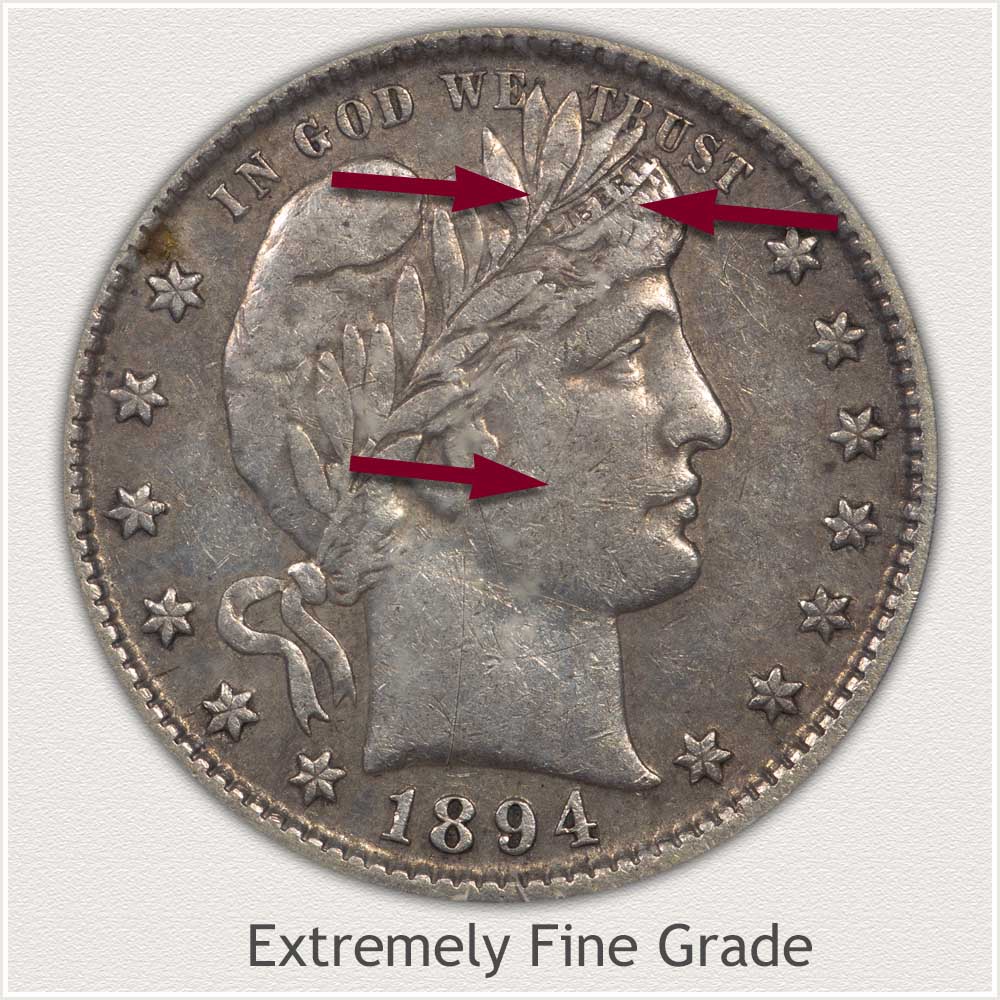
Extremely Fine: These days, Barber quarters are a very old and obsolete series. Any determined to have only minor wear are uncommon and highly collectible. Coins with wear confined only to high points of the design are classified as Extremely Fine grade.
Using specific design elements prone to early wear, the amount and loss of detail is judged. Note, there is a high-profile headband within Liberty's hair. The extent of circulation wear is determined by the state of the lettering and band, which show wear first. Strong lettering of "LIBERTY" across the band places the example well within the grade level. Also, most of the lower edge of the band remains distinct, and all letters are complete.
Features of Liberty's face and neck have only a very slight amount of smoothing, contours remain well rounded. Upon overall inspection, the coin's design is well detailed, showing many fine lines in the hair near the ribbon and knot and leaves of the wreath. To maintain their level of preservation, handle these high-condition coins by their edges.
Fine Grade
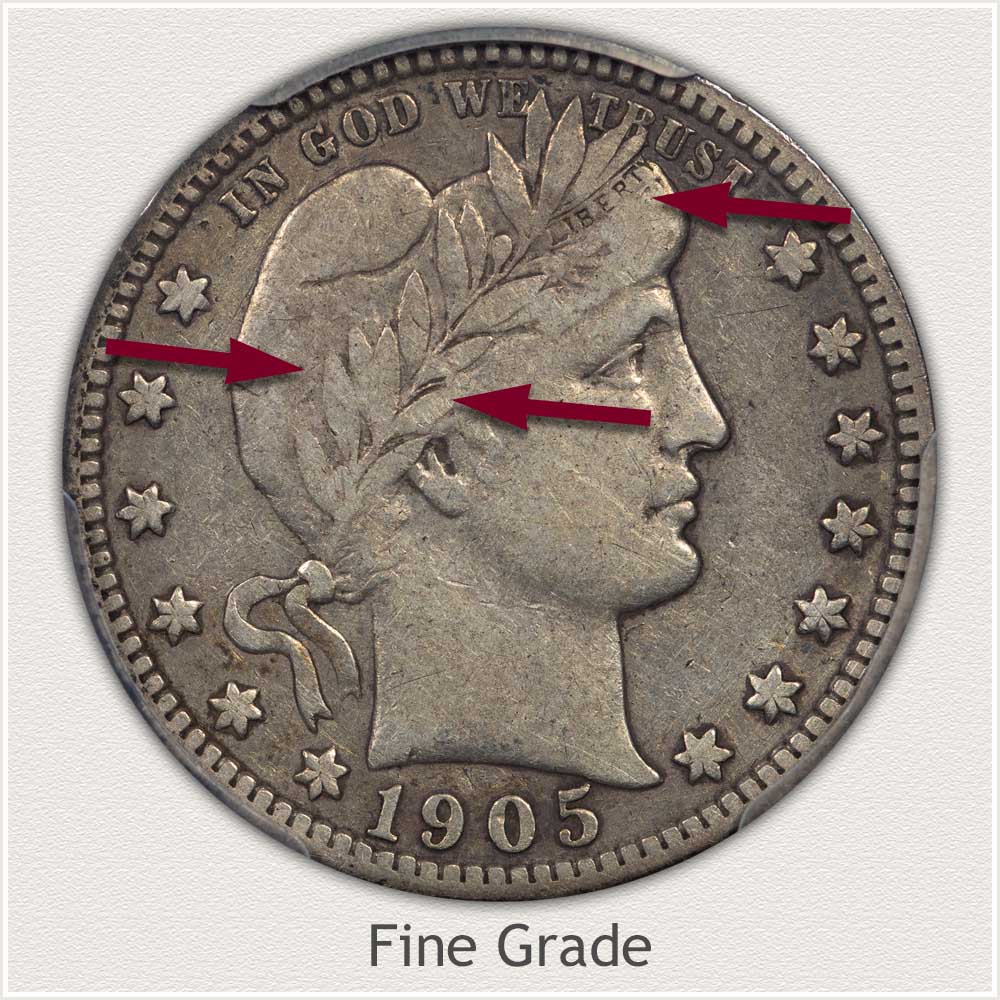
Fine Grade: Remaining an eye appealing coin is a Barber quarter in Fine grade of preservation. Condition of many of these vintage series coins is so worn that collectors have a difficult time finding pleasing examples. This rarity of condition serves as the foundation for their premium value.
All key design details are clearly defined in order to achieve the standard of Fine grade. A recognizable wreath, a headband, and the intricate knot in the ribbon used to tie the wreath's ends are all discernible. The upper row of leaves' edges are mostly visible within the wreath. A very slight blending of leaf edges is seen in a small area close to the crown of Liberty's head. The Fine grade is further identified by the bottom row of leaves are smooth and merged with her hair.
One of the most important criteria for this collectible grade is that you can read "LIBERTY" above the forehead. Nearly complete lettering; with only slight fading is acceptable.
Its overall appearance is unblemished by major marks. Fine quality represents the design of the Barber series with appeal.
Good Grade
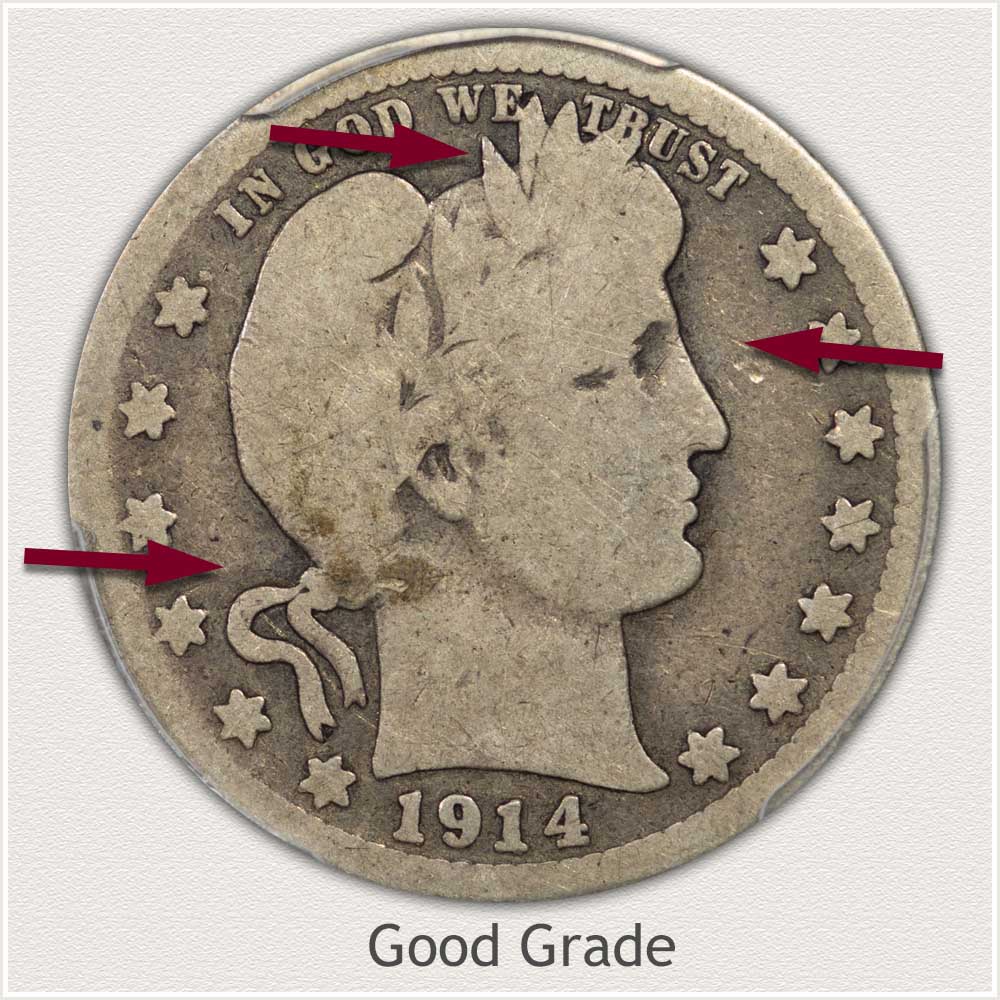
Good Grade: An attractive example of a rare date and mint combination Barber quarter in the Good grade is sought after by many beginning collectors. As a result of extensive wear, Liberty's portrait is mainly an outline, but it is strongly bold from the field.
Liberty is fully outlined on the example coin. Ribbon ends behind her head and the upper leaf edges remain distinct with no fading into the fields. A full rim and a legible date both confirm the Good grade quality. An important element of the Good grade is the complete separation of the edges of the stars near the rim.
Edges of the remaining design elements on these coins are still somewhat crisp despite their heavy wear.
How to Video: Grading Barber Quarters
A Barber quarter has key areas to judge when grading the coin. These features help identify the amount of wear and surface condition. Details in the video and descriptions focus on specific grading elements.
Video, Images and Descriptions | Grading Barber Quarters
Step 3: | Special Qualities | Original Condition
Non-Cleaned Barber Quarters are a Quality Collectible
When inspecting these old Barber quarters, a few noticeable traits help in narrowing an accurate value. Dates are first confirmed, along with mint variety. The description continues with a judgment of grade/condition of the coin. This effort begins to identify coins sought as premium collectibles worth above base silver value.
A prime consideration now becomes originality of the surface of the coin. A factor that includes if the surface is in the same condition as when put aside. Any attempts over the years to alter the surface condition are considered damage, and lowers its desirability and value.
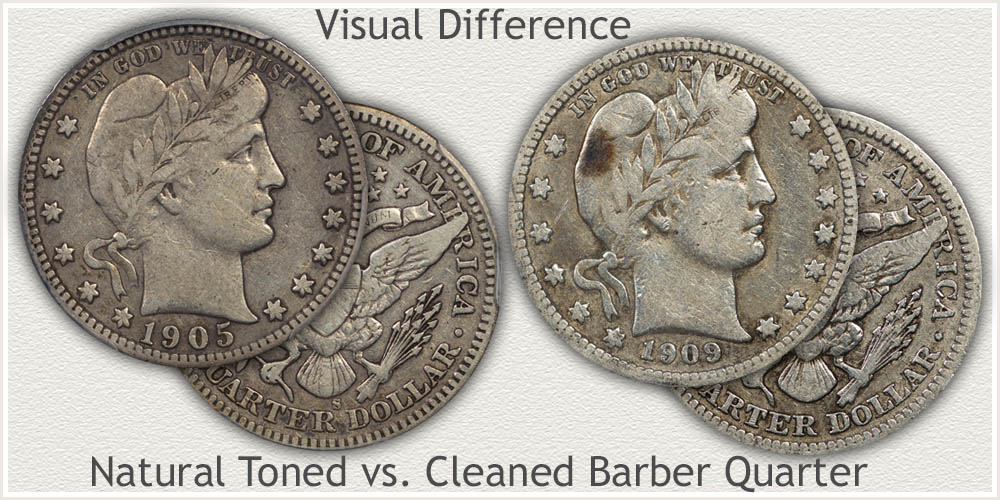
Cleaning a coin is a large reduction to its desirability as premium quality.
Observing the above quarter, noted as cleaned, it appears very bright. The silvery shine has lost the soft gray tones silver acquires over time. When comparing to the natural colors of the non-cleaned examples, the colors of a cleaned coin is less vibrant in character.
Both obverse and reverse of the cleaned coin are monotone in shading and color. Without the subtle qualities of an undisturbed surface, it lacks any appeal as a collectible.
Observe closely the vibrance of the colors displayed on the surface of your coin. Soft gray blending smoothly with light tans and darker grays indicates a typical coin without cleaning. A glossy surface on circulated pieces is suspect of a past cleaning.
References
U.S. Mint. 1903 U.S. Mint Annual Report
https://nnp.wustl.edu/library/book/514125
U.S. Mint. Catalogue of Coins of the United States.
https://nnp.wustl.edu/library/book/554591
Coin Values | CoinStudy Articles
Date by Date
In Depth Barber Quarter Values
1892 to 1916
Barber Quarter Value | Many In Demand Dates
Different condition coins are valued separately, also the many dates and mints of the Barber quarters range from common to scarce to very rare. Complete value chart of all dates and mints with condition ranges are listed. All dates of the series are in demand.
Images are used to help identify all U.S. coinage. Different series of coins and their designs are matched to your coin leading to value charts and coverage of how to value your old coins.
Popular Coin Series | U.S. Quarters
Realizing the popularity of Barber quarters helps identify the strength of the market for these coins. Coin series are charted according to numbers of serious collectors active in registry programs listing their collections. Quarter dollars, as a denomination, are ranked second to the dollar denomination.
Silver forms a solid base to many vintage U.S. coin series. Selling these coins first involves recognizing the 90% silver alloy issues, using the calculator for current worth, and finding dealers to contact. Images and descriptions identify the silver issues, and a listing of dealers buying silver coins is referenced after calculating current prices.
★Coin Values Discovery finds 1902 Quarter Value and...
All old U.S. coin values. The home page Introduces the important steps in the value process. Identifying your coin series, accurate date and mint, and images to compare when judging condition. Key elements are noted to narrow a range of how much these old coins are worth.
